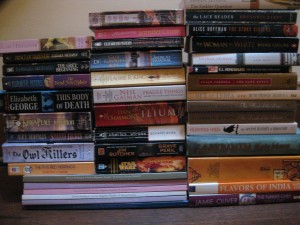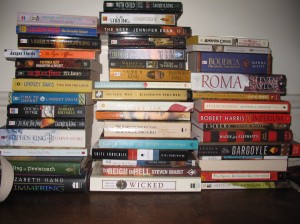Aw shucks, it’s my first internet meme. It seems reading habit discussions are going around the internet these days. I got this from Teresa and there was a great post this morning on BookEnds on childhood reading. I’d love to hear your answers, either in the comments, or on your own blog.
Do you remember how you developed a love for reading?
I don’t remember a time when I couldn’t read, but I do remember that the first chapter book I read was Enid Blyton’s Five go to Kirrin island. I also remember being in grade one and trying to go to the section in the library where I could find Charlie and the Chocolate Factory, and the librarian gently but firmly steering me back to the picture book section. Being read to as a child was crucially important.
What are some of the books you read as a child?
Do you have a few hours? I would typically bring ten to twelve books home a week from the library. Favourites, at different ages, were Enid Blyton, L.M. Montgomery, Arthur Ransome, Laura Inglis Wilder, Edward Eager, E.M. Nesbit, Elizabeth Enright, Eloise Jarvis McGraw (Greensleeves – I still reread this one), Grace Richardson (Apples Every Day – this one too), Noel Streatfield, Mara Kay, Maud Hart Lovelace, Joan Aiken, Alison Uttley, Rosemary Sutcliff, etc. etc. I also started exploring the adult section at a fairly young age, and discovered Jean Plaidy and Victoria Holt (who were, of course, the same person).
What is your favourite genre?
I’m eclectic — I’ll read the best books in any genre. Literary fiction and historical fiction, especially about times and places I don’t know much about, are old favourites. Mysteries/thrillers and fantasy are more recent loves. I haven’t read much SF (does William Gibson count?) but I expect I’ll get to it some day.
Do you have a favourite novel?
Every time I reread Doris Lessing’s Golden Notebook, Carol Shields’ Republic of Love, and Tolkien’s Lord of the Rings I get something completely different out of them. So they would be god desert island candidates.
Where do you usually read?
On my bed.
When do you usually read?
In the evening,
Do you usually have more than one book you are reading at a time?
Not happily. If I do, it means that I wasn’t enjoying my first book and I’ll probably never go back to it. So I suppose technically, I have one book that I’m reading and another I think I should be reading.
Do you read nonfiction in a different way or place than you read fiction?
I read cookbooks like I read novels. I read other non fiction for research purposes, so I am usually taking notes.
Do you buy most of the books you read, or borrow them, or check them out of the library?
I buy them, used and new.
Do you keep most of the books you buy? If not, what do you do with them?
I try to cull them periodically and I usually end up donating a bag or two to a book sale. But since much more than a bag or two of books enters my house every year, there is a problem here.
If you have children, what are some of the favourite books you have shared with them? Were they some of the same ones you read as a child?
It has been fascinating rereading old books to my son and seeing which hold up and which don’t. Madeleine L’Engle, Susan Cooper, Arthur Ransome, and The Phantom Tollbooth were as good as they ever were. All my Narnia book preferences had changed. Some old friends were not as good on rereading.
What are you reading now?
I’m in the middle of an old Elizabeth Peters, The Camelot Caper. Good fun.
Do you keep a TBR (to be read) list?
A TBR stack on the top of one bookshelf.
What’s next?
Not sure, but I just bought my very first book by Lois McMaster Bujold, Paladin of Souls, so that may be it.
What books would you like to reread?
I reread books often, which is why I keep most of the books I buy. I suspect the book I have read the most often is L.M. Montgomery’s Rilla of Ingeside. If it’s not that one, it is definitely one of hers.
Who are your favourite authors?
In no particular order, Laurie Colwin, Margaret Elphinstone, Dorothy Dunnett, Carol Shields, Mary Wesley, Margaret Drabble, A.S. Byatt, Doris Lessing, Charles de Lint, Elizabeth George, Dorothy Sayers, J.R.R. Tolkien, Angela Thirkell, P.D. James, Sarah Caudwell, Cecelia Holland, Pamela Dean, Vera Brittain, Garth Nix, Gail Godwin, Connie Willis, Susan Howatch, Susan Isaacs, Melissa Banks and I should probably shut up now because I could go on forever but there was probably something else you planned to do today.











